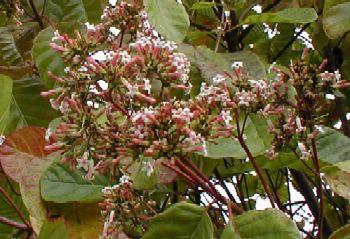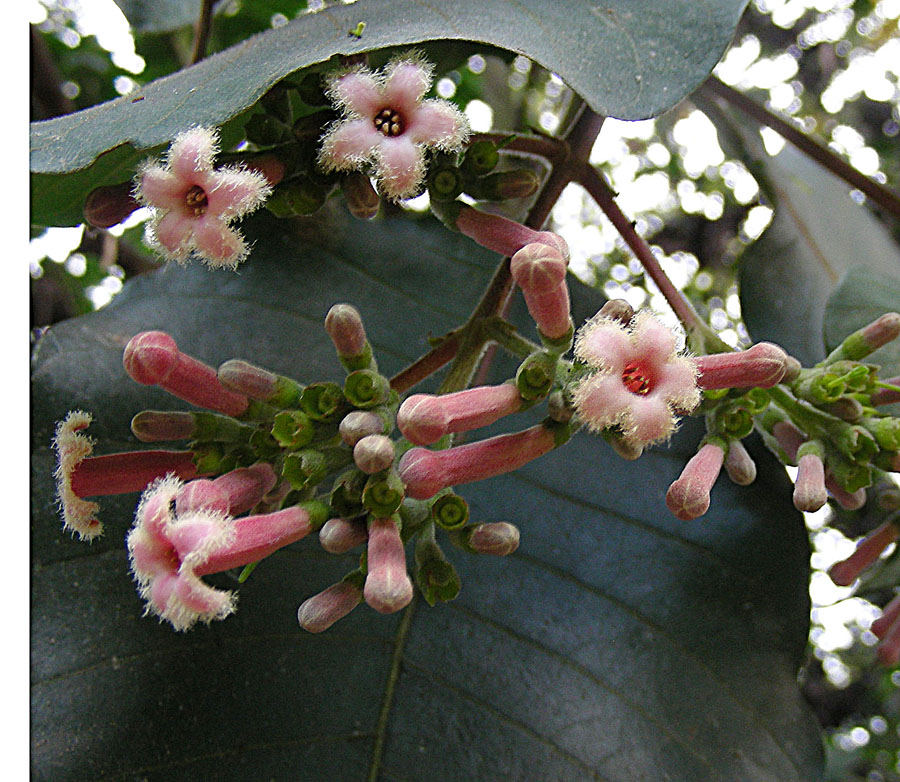Cinchona pubescens Vahl.
| Botanical Name | Cinchona pubescens Vahl. |
| Order: | Gentianales |
| Family: | Rubiaceae |
| Genus: | Cinchona |
| Species: | C. pubescens |
| Common Names: | Quinine (English), Quinquina/quinine rouge (French) |
Plant Synonyms
Cinchona succirubra Pavon ex Klotzsch
Plant Local Names
Nigeria: Yoruba- Kinin
Plant Habitat
The plant originated from South America, and was introduced and cultivated (at an altitude of between 600-3300 m) in the humid tropics of Africa and Madagascar (African Pharmacopoeia, 1985).
Plant Material of Interest
Dried stem bark
Plant Description
The genus Cinchona pubescens, among about forty species in the family Rubiaceae, is native to the tropical Andes forests of western South America but now widely cultivated in many tropical countries for its market value and particularly due to the content of quinine, an antimalarial constituent. Large shrubs or small trees with evergreen foliage, growing to 15-20 m high eaves are opposite, rounded to lanceolate and 10 - 40 cm long; the tree produces white, pink, or yellow flowers in terminal panicles; fruit is a small capsule containing numerous seeds.
Plant Used Parts
Plant Uses
Cinchona originated from the Countess of Chinchon, wife of a Viceroy of Peru, who was cured of a type of malaria fever with the bark of the cinchona tree in 1638. The name cinchona cones from "kina-kina" meaning "bark bark" in Peru. Quinine, obtained from the bark, was first proposed for sale in England in 1658 and was made official in the British Pharmacopoeia in 1677. The cinchona bark was included in many formuations in Europe, such as "Countess's powwder", "Jesuit's powder". Besides malaria, the bark was also used to treat fever, indigestion, diseases of the mouth and throat, and cancer.
Plant Therapeutic Action
Antimalarial, antipyretic, astringent, tonic, bitter antipyretic, antiarrhythmic, appetizer
Plant Precaution for Use
Alkaloid containing crude drugs must be administered with caution
Plant Adverse Effect
Over consumption causes "quinisme" (tinnitus - without stupor, dizziness, temporary hearing loss), up to a fatal coma.
Plant Contraindication
Pregnancy and patients who are hypersensitive to the cinchona alkaloids
Plant Dosage Forms
Extractum Cinchonae Fluidum (cinchona fluid Extractum Cinchonae siccum compound cinchona tincture)
The appropriate doses of cinchona depend on several factors such as the user's age, health, and several other conditions.
Plant Dosage
Plant Storage
Store in a cool dry place away from light
Plant Chromatographic Fingerprint
Plant Constituents
Quinine, quininidine, cinchonine and cinchonidine (African Pharmacopoeia, 1985); aricine, caffeic acid, cinchophyllamine, cinchotannic acid, cinchotine, conquinamine, cuscamidine, cuscamine, cusconidine, cusconine, epicatechin, javanine, paricine, proanthocyanidins, quinacimine, quinamine, quinic acid, quinicine, quinovic acid, quinovine and sucirubine (www.rain-Tree.com: Tropical plant Data Base sept, 2009).
Plant References
Buddenhagen, C.E., Renteria, J.L., Gardener, M., Wilkinson, S.R., Soria, M. et al. (2004). The control of a highly invasive tree CinchonaPubescens in Galapagos. dans Weed Technology 18:1194-1202.
Do Ce’u de Madureira, M., Martins, A.P. Gomes, M., Paiva. J., et al. (2002). Antimalarial activity of medicinal plants used in traditional medicine in S. Tome and Principe islands. Journal of Ethnopharmacology 81:23-29.
Hanlidou, E., Karousou, R., Kleftoyanni, V.,Kokkini S., (2004). The herbal market of Thesaloniki (N Greece) and its relation to the ethnobotanical tradition. Journal of Ethnopharmacology 91, 281-299.
Jager, H., Tye, A., Kowarik, I. (2007). Tree invasion in naturally treeless environments: impacts of quinine (Cinchona pubescens) trees on native vegetation of Galapagos, dans Biological conservation, vol., p. 297-307.
Kaileh, M., Berghe, W.V., Boone, E., Essawi, T., Haegeman, G. (2007). Screening of indigenous Palestinian medicinal plants for potential anti- inflammatory and cytotoxic activity. Journal of Ethnoprarmacology 113:510-516.

